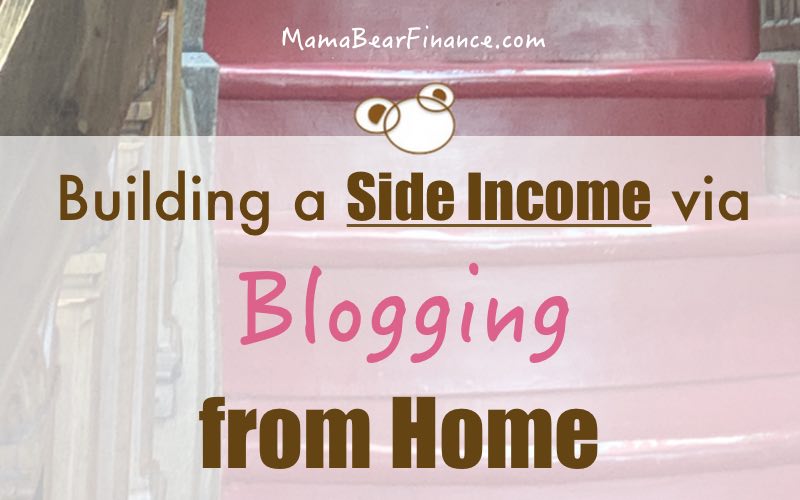The ability to create a side income via blogging has become more and more prevalent.
Indeed, the allure of building something of your own while making an income can be an attractive proposition.
But while blogging can be a great way to earn extra money, I don’t think money should be the motivator.
That’s because you might have to go through the hurdles of building up your contents in the beginning while making no money at all.
However, if you’re determined and motivated by an intrinsic reason, you might find that blogging can be a great way to build a side income.

This post contains affiliate links, which means I will receive a commission, at no extra cost to you, if you make a purchase through a link. Please see my full disclosure for further information. I was also compensated to create this post, though all opinions are my own.
Why You Should Build a Side Income
As the economy heads toward uncertainty due to the recent pandemic, I believe that more people should consider building a side income.
You never know when companies decide to downsize or eliminate roles altogether.
Furthermore, with the way things are going, it seems though companies are gearing more and more towards contract jobs in replacement of full-time positions. This period of mandatory lockdown will be a great test of efficiency and viability.
Whatever the results may be, there will surely be some disruption in the job market and layoffs will be inevitable.
That’s why it’s always a good idea to build a side income, especially one that you can do from home.
As more people surf the web, an online presence will become more and more prominent. Luckily, it’s easier than ever to start a blog (or website), earn a side income, and build a personal brand.
Let’s explore some of the ways that blogs make money (including its drawback) and how to leverage social media to drive online traffic.
Resource: A List of Blogging Tools for New Bloggers
5 Ways to Make Side Income via Blogging
When I heard the word “blogging” before starting my very own blog, I had the misconception that it was like a soapbox of random thoughts.
At least that’s what I used it for when I was a teenager more than a decade ago. I was basically airing out my random opinions and thoughts.
While some still elect to use blogging as a soapbox, many bloggers today are quite sophisticated entrepreneurs.
This doesn’t mean that they are just out to make a few bucks, but rather using blogging as a platform to transmit their knowledge and expertise. All the while telling a unique story that readers can connect to.
What’s more? They are passionate about the topics they write about, therefore it doesn’t even feel like “work!”
So how does one build a side income via blogging? Here are five simple ways the pros do it.
Related: A list of blogging tools to power a blog
1. Setting up paid advertisement
The easiest way to make money out of blogging is via paid advertisement.
This means that you can host ads from programs like Adsense, Monumetric or Mediavine, and you’ll get paid based on your web traffic. This includes pageviews, sessions and ad clicks.
It’s easy because all you have to do is set it up, and you can earn money passively as people click on your blog posts and pages.
Drawback of paid ads
Beware of the number of ads you have on your website. Having excessive ads can slow down your site’s speed and potentially drive readers away.
If you don’t have a large audience to drive up pageviews (e.g. 10k+ per month), you won’t earn much from ads. So the cost can actually outweight the benefit for many young blogs. Not to mention, they are distracting and non value-added. Therefore, I have decided to forgo the opportunity to earn ad revenues.
2. Earn money via affiliate marketing
Affiliate marketing is such a new concept to me. While the terms may sound daunting, it’s actually EXTREMELY simple to implement.
For example, as a breastfeeding mom, I know how difficult breastfeeding can be for many first-time moms. I also happen to feel passionate about the subject because of the numerous benefits that breastfeeding can provide.
As a result, I wrote an extensive post about my breastfeeding journey for the first six months. Here, I mentioned that I use breast bump and so I added an affiliate link.
An affiliate link is the entry way for readers to gain more insight about the product you’re talking about.
It is also through this medium that you can make a commission when your readers elect to make a purchase.
All you have to do is join affiliate programs such as Amazon or Share-A-Sale (among many, many others) and you can browse through a list of products related to your content.
Just be sure to write contents that TRULY add value to your readers though because doing otherwise would defeat the purpose of affiliate marketing.
Drawback of affiliate marketing
Beware to not take affiliate marketing too far by bombarding your blog posts with an excessive amount of affiliate links. Basically, you only want to include affiliate links that are relevant to your content.
And most importantly, DO NOT include affiliate links of products that you don’t believe in. This is a great way to lose trust and readership.
Not to mention, NO ONE likes to read sales pitches so it’ll be a waste of time to write contents for the sake of the sales instead of adding value to your readers.
3. Getting sponsorship
When you just start out, it might be very difficult to approach sponsors and convince them to pay you to write contents.
But as your blog grows, they might even reach out to you!
Sponsorship happens when a brand decides to pay a blogger for their content marketing service. This can be via writing a blog post and/or posting a thread on social media.
If you decide to approach sponsors, be ready with some demonstrative statistics. This includes your blog traffic size, your social media presence (number of followers, engagement level, etc.), and who is your audience that your blog serves.
Having this data in hand can be tremendously valuable for sealing a sponsorship deal or negotiating for higher payout amount.
What’s great about writing a sponsorship post is that you can still write contents that you love without overwhelming it with sales pitch. This is the best way to deliver contents and most sponsors will agree with this approach.
Plus, when you’re genuine about writing a product that you believe in, your content should flow naturally.
Drawback of sponsorship posts
Just like affiliate marketing, you really don’t want to focus too much on the product itself. But since you’re now getting paid to write a post, you may be tempted to upsell a sponsor’s product.
…Don’t.
While you can talk about the positive aspect of a product (that’s why you accepted to write a sponsored post, right?), you don’t want to upsell and lose your credibility. Basically, staying objective is key.
Furthermore, you also want to avoid working with just ANY sponsors or worst, with ones that you don’t believe in.
While sponsorship posts are a great way to earn a side income, you also want to be making money the ethical way and one that upholds your integrity.
No amount of money should be enough to buy your value. When you compromise your core beliefs with money, you’ll eventually lose brand equity. (And possibly your happiness.)
4. Selling your own products
Selling your own products is probably THE BEST way to leverage your blog to make money. It can be both physical and digital.
Do you make eco-friendly baby clothes? You can consider writing blog posts about being an environmentally-conscious mom and market the range of baby clothes that you make.
Or do you have an important knowledge you’d like to share such as how to manage family budgets? If you have a success story and concrete methodology that others can follow, you can consider writing an e-book and self-publish online.
You can also make online training courses demonstrating the expertise that you have. The great thing about this route is that this side income can potentially turn into a full-time earning. Best of all, it can be completely passive once you set it up as such.
But in order to be successful at selling your own product, you’ll need a sizable audience OR your product is truly one-of-a-kind and highly exceptional.
Drawback of selling products
It could be very time-consuming to create a product that is unique and offers a strong value proposition. The risk of putting effort in such a product is that no one buys it.
Furthermore, you may incur set-up and transaction costs of selling your own products via a platform. In essence, unless you have a sizable audience or a strong product that sells itself, you may incur a loss in both money and time.
Additional Resource: Creating Courses/E-books by Hilary Erickson
5. Selling your own services
If you have an expertise on something, you can become an online coach and sell your service. You can also do freelance work such as becoming a virtual assistant or ghost writing. Indeed, the sky is the limit when it comes to online service offerings.
For example, many finance professionals can establish an online coaching service. This is a great way to make money at home because you can sign clients online. Once scheduled, you can use free online communication tools such as Skype to host your meeting.
I think selling your service is great when you have a demonstrated knowledge in something be it finance, marketing, or health & wellness!
You can even book speaker gigs based on your online influence and advertise this service via your blog.
Drawback of selling services
One unavoidable risk of selling your services is the misalignment of expectation between you and your client.
When your client’s expectation is not met, your brand can be seriously damaged through bad reviews.
Therefore, it’s important to be selective with the clients you choose to work with. The key here is to evaluate if both parties are a good fit. You can do this by setting up a Google Form or consultation call, depending on your flexibility.
Lastly, there might even be legal risks, so make sure to have an iron-clad contract in place and consult with a lawyer if needed. (Note: This is NOT a legal advice.)
How to Leverage Social Media to Increase Online Traffic
Now that you’ve learned the five ways that blogging can generate a side income, you should also know that the key ingredient is online traffic.
Online traffic is basically the volume of incoming visitors who stop by your website. The more traffic you can garner, the higher chance of profitability.
Therefore, SEO (search engine optimization) plays an important role in generating organic traffic.
Meanwhile, social media is also a great way to attract new visitors as most people are on these platform EVERYDAY.
Related: What I Learned About Blogging as a New Blogger
Social media marketing
There are numerous tactics to leverage social media to drive traffic. One of the popular methods is to use paid advertisements, and the other is to generate organic results through engagement.
Some of the most popular social media platforms for bloggers are Facebook/Instagram, Pinterest and Twitter.
While all of these platforms require active work, you can actually leverage social media scheduling tools to reduce the workload.
For example, I noticed that the best platform for bloggers to drive traffic is through Pinterest. As such, I have been creating “pins” (vertical pictures) that you see on each of my recent blog posts.
In addition, I learned that Pinterest encourages publishing fresh and high-quality contents. This means that each “pin” should have a unique picture with an eye-catching title, such as this one:

Extra Tip: You can easily make a pin using a free photo editing tool like Canva.
Driving traffic using Pinterest
Many website owners are on Pinterest for the simple reason that it is effective in driving massive traffic. The more traffic they can attract to their sites, the more sales they can potentially get.
This is why creating fresh contents (i.e. pins) on Pinterest is so important.
The goal of these “fresh pins” (new pins for recent or existing blog post, page, or product listing) is to inspire “pinners” (those who use Pinterest) to engage, save and click on your pins.
But since “pinning” (saving a pin) is often required to be done regularly, this means that it can take some active effort on our part as bloggers.
Fortunately, services such as Tailwind can help with batching and scheduling pins so that your Pinterest account remains active.
What I’ve found is that fresh contents really work on Pinterest. The more I pin, the more my viewers and engagement have grown. And it seems like Pinterest’s algorithm really loves fresh pins, because I would instantly get traffic after pinning.
If you want to learn more about Pinterest, check out this e-course that shows you the full process of using Pinterest to your benefit.
Also check out the Smartguide provided by Tailwind to learn how you can adhere to Pinterest’s marketing best practices.
Final Thoughts on Building a Side Income
Just a decade ago, people would not even bat an eye on the proposition of making money at home.
Do you remember when Youtubers would announced that they planned to forgo attending universities or finding a “real job” in favor of making Youtube videos online?
I remembered. It sounded absurd to me!
Perhaps I came from a background of scarcity mindset, but I just couldn’t jeopardize my long years of studying to take a chance on my own.
However, after a decade of grinding at a traditional job, I’m now fully open to the possibility of working from home.
I don’t think I would be successful as a blogger back then, because I had too much worries about money. It’s really tough to go through the “lean years” without getting a dime while pouring your energy out.
That’s why it’s best to do it when you’re ready.
And when you are, the sky is truly the limit.
Resources: A Comprehensive List of Blogging Tools

What are other side income opportunities that we can explore as stay-at-home moms? If you’re a blogger, what other ways do you make income via blogging? Which social media platform is the best in driving online traffic?
PINNING don’t stop




I’m definitely not at this stage with my blog, as I have just been doing it for experience and enjoyment, however, it is great to see what it could turn into if you would like it to. Subscribed, looking forward to your future posts! 🙂
I totally agree. In these uncertain times, it’s a great idea to have side hustle that makes you some extra money. And blogging is definitely one way to do that.
That was a great read. I needed a few info as I am very new to blogging. You have really explained it well. Keep going
I appreciated this post and how you listed examples for every point. Loved this and I think this information is going to help me a great deal in getting more traffic to my blog.
Love how you indicate the positive side and the downside of every side job you’ve indicate as it can help us understand it more. I’m actually interested on affiliate links but I still have a new blog and so i shouls work out on social media sites which have you indicated, thanks for the useful information about pinterest!
Not a problem! Glad to help!!
That’s some quality information. Keep going 🙂
Thank you! 😀 Will do!
Love how you broke down the five ways of monetizing a blog!
Thanks, Kelsey!
Great post! Offering a service is probably the fastest way to make a side income blogging. I’m doing it in reverse–I built a very successful service business (freelancing) and now I’m making money blogging.
Building a successful online service is great and having a blog will propel your business further!